The Elegant Municipal Building — 1914
by Paula Bosse
 A very un-Dallas-looking building … and one of its finest
A very un-Dallas-looking building … and one of its finest
by Paula Bosse
Appearing in the May 7, 1914 issue of Municipal Journal was a short article on Dallas’ then-under-construction Municipal Building and a drawing of what it would look like when completed.
Dallas Will Have Modern Municipal Building
Dallas, Tex. – The new municipal building of the city of Dallas is nearing completion and will be ready for occupancy in a few months. It will house all of the city departments and in addition will have a modern emergency hospital in the basement and public rest rooms for both men and women. The building is said to be a radical departure in architectural design from the usual type of public buildings in the South; it is constructed along simple but dignified lines. The structure will be of steel construction covered with blue Bedford stone, the five stories, basement and sub-basement will be a home worthy of the city of the hour, as Dallas people like to call their town. Ventilating and heating systems are being installed together with vacuum cleaners. The building, without furnishings, will cost about $550,000. C. D. Hill and Company are the architects. The structure was started by the Fred A. Jones Building Company, which failed just as the steel was up, and it is being finished within the estimates by the city under the supervision of the architects.
This new City Hall, located at Main, Harwood, and Commerce, was designed by Dallas architect C. D. Hill. Construction began in late 1913 — by January of 1914, its steel frame was in place.
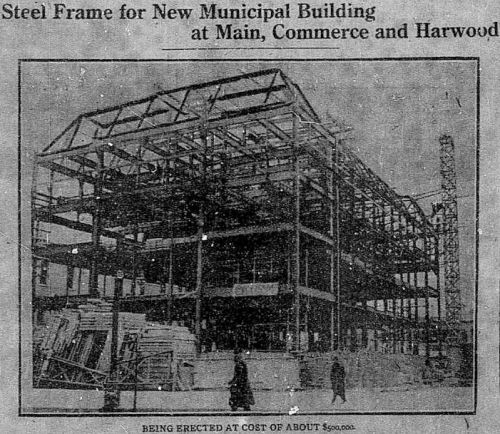 Dallas Morning News, Jan. 1, 1914
Dallas Morning News, Jan. 1, 1914
The cornerstone was laid in a Masonic ceremony on Valentine’s Day, 1914.
 Fort Worth Star-Telegram, Feb. 15, 1914
Fort Worth Star-Telegram, Feb. 15, 1914
As the construction was winding down, workmen complained of an “intolerable” swarm of mosquitoes flying around the site. Apparently an underground spring was flooding the sub-basement and providing palatial digs for endless cycles of constantly-hatching mosquitoes. (I wonder if the basement still floods on occasion?)
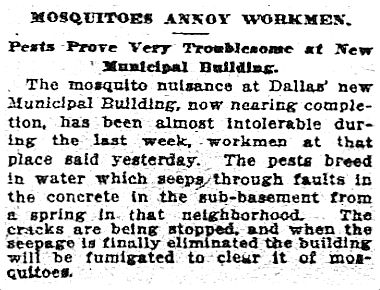 DMN, Sept. 10, 1914
DMN, Sept. 10, 1914
The building was officially opened on October 17, 1914. Here’s a grainy photo that absolutely does not do that beautiful building justice.
When the doors were finally opened to the public, it was expected that a few thousand people would show up to tour their new municipal building — in actuality, the much-larger-than-anticipated crowd numbered somewhere between 12,000 and 15,000 curious Dallasites.
 DMN, Oct. 18, 1914 (click for larger image)
DMN, Oct. 18, 1914 (click for larger image)
The beautiful exterior was faced with granite and stone, and the interior boasted marble, mosaic tilework, and wood paneling. All of the furniture used in the building was made in Dallas. In addition to the mayor’s office, fire, police, and other municipal departments, the building also housed an emergency hospital, a sub-basement shooting range (!), and, on the 3rd floor, an 1,100-seat auditorium, with a 4th-floor gallery. (The auditorium was designed so that if, in the future, it was determined that it was not needed, it could easily be converted to office space by adding a few columns and beams — a renovation which obviously happened at some point.) Interestingly, the northern half of the top floor was left unfinished as the space was not needed at the time.
ALSO included in the new building’s amenities were much-needed public restrooms (or as they were euphemistically referred to back then, “comfort stations”). A men’s restroom and a women’s restroom (“positively divided with heavy walls”) were located under the Main Street sidewalk, accessible down stairs on either side of the building’s entrance. Up until this point, there was only ONE public “comfort station” in the city (for women and children) — at Fair Park. So for most downtown visitors, this might well have been the most exciting aspect of Dallas’ newest landmark.
The building referred to as both “City Hall” and “the Municipal Building” was considered to be one of the city’s finest and most elegantly imposing. But there are always a few people who just don’t like nice things, and there was a surprising amount of vandalism to the building in its first few weeks.
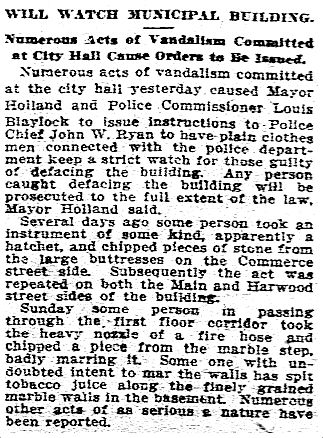 DMN, Nov. 10, 1914
DMN, Nov. 10, 1914
This is one of the truly great buildings in Dallas, and it just recently celebrated its 100th birthday. It is a Dallas Landmark and a Texas Recorded Historic Landmark. No longer a city property, it is now part of the University of North Texas Dallas College of Law campus (along with the old Titche’s building). UNT is currently working to restore and renovate this beautiful historic building. Thank you, UNT!
*
A few images of the building over the years. Here it is in its pristine early days:
Then there was a weird middle-age-crazy period when someone thought that the addition of awnings would be a good idea (that person was incorrect).
And, today, it’s back to looking distinguished and lovely. Thanks to the wonderful new open park in front of it, it has been given the stately space it deserves — what may be Dallas’ most beautiful building is finally able to be fully admired from a respectful distance.
***
Sources & Notes
Top photo from the book Historic Photos of Dallas by Michael V. Hazel (Nashville: Turner Publishing Co., 2006).
Quote from Municipal Journal, Vol. XXXVI, No. 19 — May 7, 1914.
Photo of the old Municipal Building today by Joe Mabel, from Wikipedia. (And, yes, the parking garage of the Dallas Municipal Building is where Ruby shot Oswald.)
Newspaper photos and clippings as noted.
For a detailed description of the architectural details, design elements, and description of office and department locations within the building, see the article “Municipal Building Handsome Structure” (DMN, Oct. 4, 1914), here.
I’d love to know more about the little “aluminum trays, bearing a picture of the building” mentioned as being given away on opening day in an article above. There were FIVE THOUSAND of them given away. Surely there are some still around. Has anyone seen one of the these?
 DMN, Oct. 18, 1914
DMN, Oct. 18, 1914
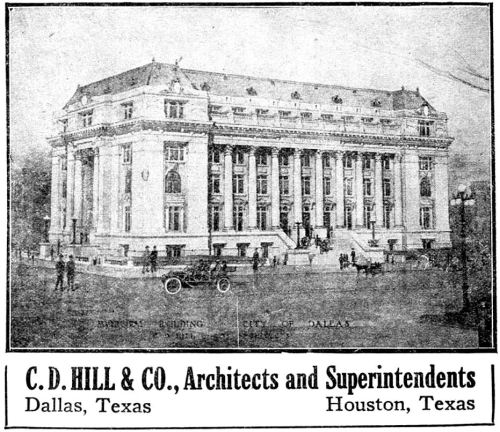 1914 Texas Almanac ad for C. D. Hill & Co.
1914 Texas Almanac ad for C. D. Hill & Co.
*
Copyright © 2015 Paula Bosse. All Rights Reserved.

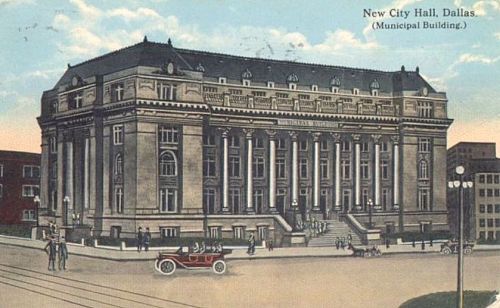

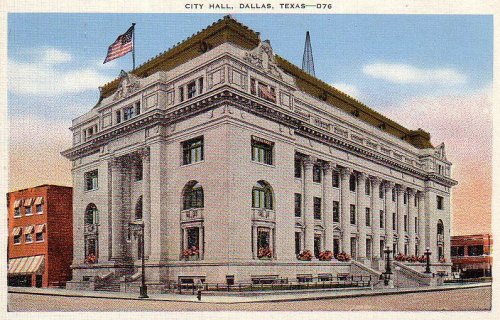

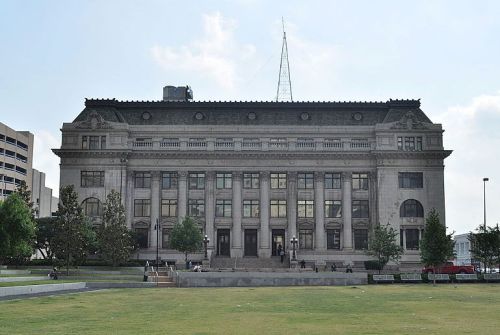
I love that 1st pic. Here is a 70’s one from The red oak kid on Flickr.         Â
LikeLike
Thanks! There isn’t an image. Do you have link?
LikeLike
Here is an image of the Jamestown, NY city hall souvenir mini tray, which is probably what the Dallas version looked like:

LikeLike
I bet you’re right, Teresa. There have to be some of these lying around town somewhere! Thanks!
LikeLike
I think that third floor auditorium (or least part of it) still exists. Until a few years ago it was used as an off docket courtroom and an assembly hall for jury duty.
LikeLike
That’s interesting. Imagine a government building that had room for such a large auditorium — and a half-empty top floor!
LikeLike
THE ONE GREAT STORY IS that Col Greene who brought the first car too Dallas did live next door, and that was the future in 1914…..odd, and it would stay that way until the 1940’s…Dallas had a big city look in that area from 1914 too 1950’s, then the image faded and people moved to suburbia, thus you can see why the library was also in that area, that was the center of the City for several decades, then Ruby killed Oswald there an the place really has been I am told cursed…..
.During the 1920’s that was also the second headquarters of the K.K.K and they hid well there and drove too their offices int he fair park area, so things did connect then…
.we have 3 locations Dallas became centers back then ……Red Court House and records building and jail was one of them…by 1936 the location was in decline as far as central government was in control, since it is really a W.W.1 period location..these are again great images hand colored by Arnold it may be realized…..postcards were sold in Drugstores…..
LikeLike
The views the Municipal Building and the Wilson Building enjoy in present-day Dallas call to mind the famous 1941 Punch cartoon depicting post-Blitz London. In that cartoon a couple regard St. Paul’s Cathedral across a broad expanse recently cleared of rubble, and the wife observes “Actually this is now very much as Wren intended us to see St. Paul’s.”
LikeLike
Ha! Exactly!
LikeLike
what you should realize the amazing thing about Dallas is that it wanted too get away from the small town theme, that was so common, in most places, and the big city theme had too have centers, lavish new york style greek and roman building of power and image, and that was the blaylock era, by the way, when reform came too dallas and the center would look like st louis, the 1930s was a chicago image…..and when they hired people to make this city it was out side..to create a better image…
LikeLike
When we were kids, my cousins and I used to call this “the Mvvnicipal Bvvvvlllding”, because of the Classical inscription (MVNICIPAL BVILDING) on the pedimient. We all knew that in Classical Latin, V = U, of course; but we were kind of weird kids. (Our number one hangout: the Casa View Branch library). Fittingly, one of those cousins went on to have a career as a high school Latin teacher. Intemperans adulescentia effetum corpus tradit senectuti
LikeLike
[…] “THE ELEGANT MUNICIPAL BUILDING — 1914.” A look at what may be Dallas’ most classically beautiful […]
LikeLike
[…] More on the building of the City Hall/Municipal Building in the post “The Elegant Municipal Building — 1914,” here. […]
LikeLike
[…] “The Elegant Municipal Building — 1914” […]
LikeLike
[…] How it all began: my Flashback Dallas post “The Elegant Municipal Building — 1914.” […]
LikeLike
[…] on a 1921 Sanborn map here.) Both were designed by Dallas architect C. D. Hill, whose spectacular Municipal Building would be built a couple of years later, two and a half blocks […]
LikeLike